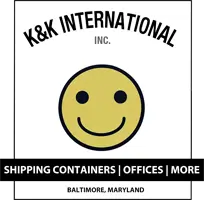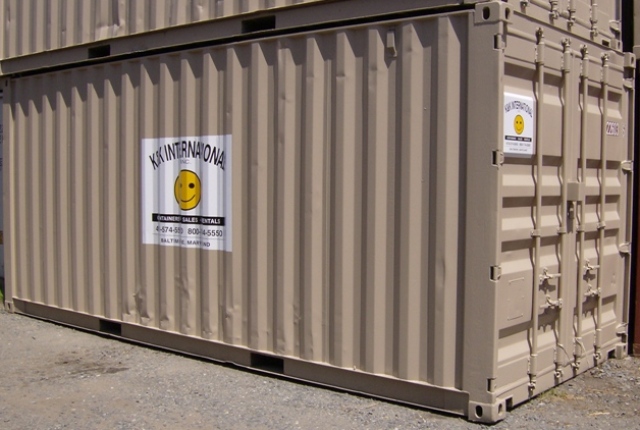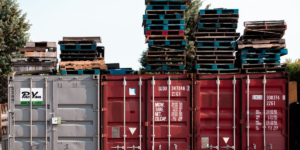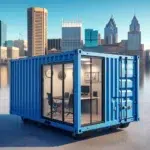Shipping containers have become increasingly popular in recent years as a versatile and cost-effective solution for building projects. Originally designed for transporting goods across the globe, these steel boxes have found new life as innovative building materials. From homes and offices to retail stores and community centers, shipping containers offer endless possibilities for sustainable construction.
The versatility of shipping cargo containers for sale lies in their modular design and standardized dimensions. These containers are available in various sizes and can be easily stacked and combined to create larger structures. They can be modified and customized to meet specific needs, making them suitable for a wide range of building solutions.
4 Benefits of Using Shipping Containers for Building Projects
- One of the main advantages of using shipping containers for building projects is their cost-effectiveness compared to traditional building materials. The price of a shipping container is significantly lower than that of bricks, concrete, or timber. This makes it an attractive option for those on a tight budget or looking to save money on construction costs.
- In addition to being cost-effective, shipping containers are also durable and weather-resistant. Made from high-quality steel, they are built to withstand harsh conditions at sea, making them highly resilient to extreme weather events such as hurricanes or earthquakes. This durability ensures that the structure built with shipping containers will last for many years with minimal maintenance.
- Another benefit of using shipping containers is their ease of transport and installation. These containers are designed to be transported by trucks, trains, or ships, making them easy to move from one location to another. Once on-site, they can be quickly installed and assembled, reducing construction time and labor costs.
- Furthermore, shipping containers are eco-friendly and sustainable. By repurposing these containers for building projects, we are reducing waste and minimizing the need for new construction materials. This helps to conserve natural resources and reduce the carbon footprint associated with traditional construction methods.
The Different Types of Shipping Containers Available for Sale
When considering using shipping containers for building projects, it is important to understand the different types available for sale. Each type has its own unique features and specifications, which can affect the suitability for specific building solutions:
- Standard containers: These are the most common type of shipping containers and come in standard sizes of 20 feet or 40 feet in length. They have a height of 8 feet and a width of 8 feet, making them suitable for most building projects.
- High cube containers: High cube containers are similar to standard containers but have an additional foot in height, measuring 9 feet tall. This extra height provides more vertical space and can be beneficial for projects that require taller ceilings or additional storage space.
- Open-top containers: Open-top containers have a removable top, allowing for easy loading and unloading of oversized or bulky items. They are often used for transporting goods that cannot fit through the standard container doors.
- Refrigerated containers: Also known as reefer containers, these are equipped with a cooling system to maintain a specific temperature range. They are commonly used for transporting perishable goods such as food or pharmaceuticals.
- Flat rack containers: Flat rack containers are comprised of collapsible sides and ends, making them suitable for transporting irregularly sized or shaped cargo. They can be used as a base for building structures that require an open floor plan.
Factors to Consider When Choosing a Shipping Container for Building
When choosing a shipping container for a building project, there are several factors to consider to ensure the container meets your specific needs and requirements:
- Size and dimensions: The size and dimensions of the container should be carefully considered to ensure it fits the intended purpose. Standard containers are typically sufficient for most building projects, but high cube containers may be necessary if additional height is required.
- Condition and quality: It is important to inspect the condition and quality of the container before purchasing. Look for common signs of damage like dents, rust, and structural deformities that could affect its integrity. It is also advisable to choose containers that have been certified as wind and watertight to ensure they are suitable for construction purposes.
- Location and accessibility: Consider the location where the container will be placed and the accessibility of the site. Ensure there is enough space for delivery and installation, and that there are no restrictions or obstacles that could hinder the process.
- Purpose and function: Determine the specific purpose and function of the building project to determine the necessary modifications and customizations. For example, if the container will be used as a living space, insulation and ventilation will be important considerations.
The Cost of Shipping Containers and How to Find Affordable Options
The cost of shipping containers can vary depending on several factors, including size, condition, and location. On average, a used shipping container can range from $1,500 to $4,500, while a new container can cost between $3,000 to $6,000 or more. However, prices can fluctuate based on market demand and availability.
Factors that can affect the price of shipping containers include:
- Size: Larger containers tend to be more expensive than smaller ones.
- Condition: New or one-trip containers are generally more expensive than used ones.
- Location: Containers located in areas with high demand or limited supply may be priced higher.
- Modifications: Containers that have been modified or customized may have an additional cost.
Purchasing used shipping containers instead of a new one will often save you money, especially in the short-term. Used containers are often in good condition and can be significantly cheaper than new ones. It is also advisable to compare prices from different suppliers and consider purchasing from local sources to avoid high transportation costs.
How to Modify and Customize Shipping Containers for Building Projects
One of the advantages of using shipping containers for building projects is the ability to modify and customize them to meet specific needs and requirements. Here are some common modifications and customizations that can be done to shipping containers:
- Cutting and welding: Shipping containers can be cut and welded to create openings for doors, windows, or other desired features. This allows for easy access and natural light to enter the space.
- Insulation and ventilation: To ensure comfort and energy efficiency, insulation can be added to the walls, floor, and ceiling of the container. Ventilation systems can also be installed to regulate airflow and prevent condensation.
- Electrical and plumbing: Containers can be equipped with electrical wiring, outlets, and lighting fixtures to provide power for appliances and devices. Plumbing systems can also be installed to provide access to water for sinks, showers, or toilets.
- Exterior and interior design: The exterior of the container can be painted or clad with different materials to enhance its appearance and blend with the surrounding environment. The interior can be designed and furnished according to the desired function, whether it is a living space, office, or retail store.
Top Sustainable Building Solutions Using Shipping Containers
Shipping containers offer a wide range of sustainable building solutions that are both practical and environmentally friendly. Here are some of the top uses for shipping containers in sustainable construction:
- Container homes: Shipping containers can be transformed into comfortable and stylish homes. They offer a cost-effective alternative to traditional housing while reducing the carbon footprint associated with new construction materials.
- Office spaces: Shipping containers make excellent office spaces due to their modular design and ease of customization. They can be easily expanded or relocated as business needs change.
- Retail stores: Shipping containers are increasingly being used as pop-up shops or permanent retail stores. Their compact size and portability make them ideal for temporary installations or small businesses.
- Pop-up shops: Pop-up shops are temporary retail spaces that can be set up quickly in various locations. Shipping containers provide a convenient and eye-catching solution for pop-up shops, allowing businesses to showcase their products or services in a unique way.
- Community centers: Shipping containers can be used to create community centers that serve as gathering spaces for various activities and events. These centers can provide much-needed facilities in underserved areas or act as temporary solutions during the construction of permanent structures.
Creative Ideas for Building with Shipping Containers
In addition to the more common uses for shipping containers, there are also many creative and unique ideas for building with these versatile structures. Here are some examples:
- Swimming pools: Shipping containers can be transformed into stylish swimming pools by adding a pool liner and filtration system. They offer a cost-effective and space-saving solution for those who want a pool but have limited space or budget.
- Greenhouses: Shipping containers can be converted into greenhouses to grow plants and vegetables. With the addition of insulation, ventilation, and lighting, they can provide an ideal environment for year-round gardening.
- Art studios: Artists can use shipping containers as art studios, providing a private and inspiring space to create their work. The containers can be customized with large windows or skylights to allow natural light to flood the space.
- Gyms: The durable construction of shipping containers combined with their ease of customization makes for excellent small or medium-sized gyms. A container gym can be added to an existing commercial or residential property without excessive site planning or advanced materials.
- Restaurants: Shipping containers offer a unique and trendy option for restaurants and food establishments. They can be customized with kitchen equipment, seating areas, and outdoor dining spaces to create a one-of-a-kind dining experience.
The Future of Shipping Container Building and its Environmental Impact
The use of shipping containers for building projects is expected to continue growing in the future as more people recognize their benefits and potential. Advancements in technology and design will further enhance the versatility and functionality of shipping container structures.
From an environmental perspective, shipping container building has the potential to significantly reduce the carbon footprint associated with traditional construction methods. By repurposing existing containers, we are reducing the need for new construction materials and minimizing waste. Additionally, the modular nature of shipping containers allows for easy disassembly and relocation, reducing the impact on land and resources.
However, there are also challenges and limitations to consider. Shipping containers have limited interior space, which may not be suitable for larger building projects. They also require proper insulation and ventilation to ensure comfort and energy efficiency. The transportation of shipping containers can contribute to carbon emissions if not done efficiently.
Frequently Asked Questions About Cargo Containers for Sale
What are shipping cargo containers?
Shipping cargo containers are large metal boxes used for transporting goods across the world. They are made of steel and come in various sizes, ranging from 10 feet to 40 feet in length.
What are the benefits of buying shipping cargo containers for sale?
Buying shipping cargo containers for sale can be a cost-effective solution for storage or transportation needs. They are durable, weather-resistant, and can be easily modified to suit specific requirements.
Where can I buy shipping cargo containers for sale?
Shipping cargo containers for sale can be purchased from various sources, including shipping companies, container dealers, and online marketplaces. It is important to research the seller and inspect the container before making a purchase.
What factors should I consider when buying shipping cargo containers for sale?
When buying shipping cargo containers for sale, it is important to consider factors such as size, condition, age, and modifications. It is also important to consider the transportation and delivery costs associated with the purchase.
What modifications can be made to shipping cargo containers?
Shipping cargo containers can be modified to suit various needs, including adding windows, doors, insulation, and ventilation. They can also be stacked or joined together to create larger structures, such as homes or offices.
What are the shipping costs associated with shipping cargo containers?
The shipping costs associated with shipping cargo containers vary depending on the size and destination of the container. It is important to research shipping companies and compare prices before making a purchase.
Unlocking the Potential of Shipping Containers for Sustainable Building Solutions
Containers offer a versatile and cost-effective solution for sustainable building projects. Their modular design, durability, and ease of customization make them suitable for a wide range of applications. From homes and offices to retail stores and community centers, shipping containers have unlocked endless possibilities for sustainable construction.
Ready to get started on your container project? Request your quote now and our team will get back to you promptly. We look forward to working with you!












